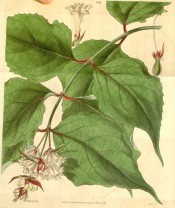Leycesteria formosa Wall.
Fully hardy, upright, thicket-forming shrub with bamboo-like first-year shoots, ovate, pointed leaves to 17cm long, and axillary or terminal, pendant spikes, to 10cm long, of white flowers among dark purple-red bracts, in summer and autumn, followed by red-purple berries. To 2m. [RHSE, Hortus, Hilliers’].
Horticultural & Botanical History
‘From the account given of this plant by Dr. Wallich, and from the bright scarlet colour represented in that eminent Botanist’s Plantae asiaticae rariores as belonging to the bracts, it was expected that this would prove a most ornamental addition to our gardens. But it must be confessed that it does not justify that expectation. It has been raised in the garden of the Horticultural Society from seeds procured from India by Dr. Royle, and proves to be a hardy evergreen, capable of sustaining the severest cold of winter without protection. But its leaves are a pale dull green, it has a rambling inelegant mode of growth, and the colour of the bracts is not at all brighter than what is represented in the accompanying plate.’ [BR f.2/1839]. Introduced to Britain in 1824 and first flowered by Messrs. Allen and Rogers of Battersea. [MB p.15/1841]. BM t.3699/1839.
History at Camden Park
Listed in the 1850 and 1857 catalogues [T.635/1850]. It was probably obtained from Loddiges’ nursery as it was included among desiderata in a letter dated 16th April 1846. [MP A2933-1, p.147].
Notes
Published Jul 08, 2009 - 02:55 PM | Last updated Jul 16, 2010 - 01:58 PM
| Family | Caprifoliaceae |
|---|---|
| Category | |
| Region of origin | Himalayas |
| Synonyms | |
| Common Name | Himalayan honeysuckle |
| Name in the Camden Park Record | Leycesteria Formosa |
| Confidence level | high |
